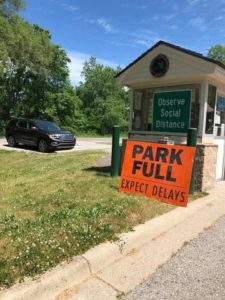The dog days of summer have arrived but the news hasn’t stopped. The latest News to Us shines some summer sun on the coronavirus-inspired boom in outdoor recreation, continued Border-to-Border trail developments, and new data on flood risks and Lake Erie algal blooms. Dive in below to read more.

Pandemic has not slowed Border-to-Border trail progress, officials say
Even with the coronavirus pandemic complicating construction logistics, planned Border-to-Border (B2B) trail developments in the Huron River watershed are on track to be completed this year. New B2B developments include a a tunnel under M-52, additional parking spaces along the Chelsea-Stockbridge connection, and trail repaving in Ypsilanti. With trail use around the country soaring due to the COVID-19 pandemic, the improvements come at an ideal time.
Moderate algae bloom forecast for Lake Erie this summer
In its latest Lake Erie harmful algal bloom forecast, the National Oceanic and Atmospheric Administration predicts a moderate bloom for 2020. The forecast predicts the 2020 bloom will reach a 4.5 on its biomass-based severity index compared to last year’s bloom rated at 7.3. The drop in this year’s severity is largely due to the decline in spring rainfall from 2019, which is largely responsible for washing manure and chemical fertilizers into waterways. Even with small sized blooms there is still a chance of high toxicity.
Parks and recreation interest spikes as Michigan reopens
With stay-at-home orders and travel advisories in place due to the coronavirus, state park attendance and outdoor recreation sales have skyrocketed. Parks and recreation staff and outdoor recreation retailers are scrambling to keep up. Increased visitors compounded with early season hiring and non-essential work freezes has left parks and recreation staff across the state busy de-winterizing, repairing, and managing the facilities. With this boom in outdoor recreation, retailers have also struggled to keep inventories stocked and customers satisfied.
Newly published efforts by the First Street Foundation reveal nearly two times as many homes are at risk of flood damage than previously thought. The new calculations identify an additional 8.7 million properties across the country with flood risk. To inform their model, researchers at First Street Foundation took into account sea-level rise, rainfall, and flooding along smaller creeks not mapped federally. The data, which identifies a property’s flood risk, is available at floodfactor.com.
On top of garlic mustard, purple loosestrife, and buckthorn, two new invasive species, the European frog-bit and red swamp crayfish, have been spreading throughout Southeast Michigan. In an effort to fight these invaders, the Oakland County Cooperative Invasive Species Management Area (CISMA) will survey public and private lands in the Huron, Rouge, and Clinton River watersheds to determine the extent to which frog-bit has spread throughout the county. These assessments, which will be conducted in collaboration with HRWC and other Southeast Michigan watershed groups, will inform response plans to prevent its spread into Oakland County’s boating lakes.
In a late June 72-25 vote, the Senate approved the Great American Outdoors Act, which allocates billions of dollars to alleviate a national park project backlog and permanently funds the federal Land and Water Conservation Fund (LWCF). Established over 50 years ago, the LWCF uses oil and gas revenues to protect and restore natural areas. The bill now heads to the house for an expected late July vote. President Trump has indicated he will sign the bill into law if passed by Congress. If signed into law, the bill would be the most significant conservation legislation in nearly half a century.



